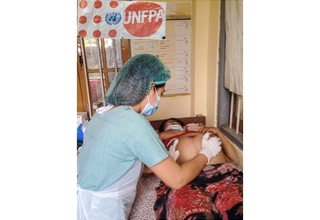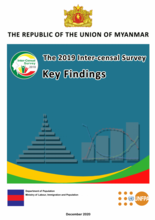YANGON, Myanmar — A new census report reveals that the number of older people in Myanmar will almost triple in the next 30 years. By 2050 the number of people aged 60 and over are projected to grow from 4.5 million to 13 million – 20 per cent of the population.
“Both the Government and civil society must prepare to meet the challenges and opportunities of a gradually ageing population. Policies and programmes need to take into account the increase of older people and their needs”, says Janet Jackson, UNFPA Representative for Myanmar.
However, Myanmar does have some significant advantages. Compared to many other countries in the region, such as Singapore, Malaysia and Thailand, its population is ageing at a relatively slow rate. In 2050, Myanmar’s age structure will be similar to that of Singapore’s today. The gradual change gives the country time to adjust as its older population grows.
The findings come from the 2014 Myanmar Population and Housing Census Thematic Report on the Older Population, published by the Ministry of Labour, Immigration and Population and UNFPA. The report shows that 22 per cent of people aged 65 and above still work. The majority of these work in agriculture, which is a physically demanding sector.
“The data suggest that economic realities oblige many people to continue heavy manual labour into old age to survive. This underlines the need for adequate social services, protection mechanisms and policies that serve older people,” says Janet Jackson, UNFPA Representative for Myanmar.
Most people over 60 were born between 1925 and 1950. Their access to education was influenced by the times through which they lived. This is why illiteracy levels are high among older people (20.9 per cent). The number is much higher for women, and it varies across the country. In Shan and Chin, for example, only one in three women over 60 can read and write.
According to the report, more older women (45.7 per cent) than older men (17.4 per cent) are widowed. This is because life expectancy is lower for men (60.2 years) than for women (69.3 years), and because women tend to marry younger. This could put older women at higher risk of isolation and deprivation, as they live out old age without their life partner. However, this is counterbalanced by the firm practice of older people living with their adult children. The marital status of an older person has very little effect on whether or not they live alone.
“While most people are able to grow old surrounded by an extended family, there are still many people who face old age alone. Myanmar needs to develop safety nets for old people, such as a universal pension scheme,” says Janet Jackson, UNFPA Representative for Myanmar.
Download: 2014 Myanmar Population and Housing Census: Thematic reports
***
For more information, please contact:
Yenny Gamming; Tel: +95- (0)9 2604 00005; gamming@unfpa.org
Si Thu Soe Moe; Tel: +95- (0)9 4500 57730; soemoe@unfpa.org
UNFPA, the United Nations Population Fund, delivers a world where every pregnancy is wanted,
every childbirth is safe and every young person’s potential is fulfilled.
Notes to Editors
The census project
The main results of the 2014 Myanmar Population and Housing Census were published in May 2015. This thematic report is part of a series of thematic reports on diverse topics. The thematic reports contain new data as well as previously released data which have been statistically adjusted for higher accuracy. The reports analyse the relationship between different data, and shed light on what the numbers tell us about the lives of people in Myanmar. The census was conducted by the Government of Myanmar. UNFPA has provided, and continues to provide, technical and financial support towards the census.
Non-enumeration
An estimated 1,090,000 people who wished to self-identify as Rohingya were not enumerated in the census. UNFPA recognizes their non-enumeration as a serious shortcoming of the census and a grave human rights concern, and regards it as critical that all rights are restored as soon as possible. An estimated 69,700 people in Kayin State and 46,600 people in Kachin State were also not enumerated. In total, an estimated 1.2 million people were not enumerated in the census. These estimated 1.2 million people were included in the total population count of 51.5 million. However, since data on characteristics is not available for the people who were not enumerated, the data and analysis presented in this report covers only those enumerated during the census.
Online census library
Census reports can be accessed on the UNFPA website or on the Department of Population website.




